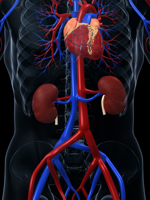2015 WWMB Project
Blood Flow Autoregulation in the Kidney
Project Leaders:
Anita Layton, Mathematics, Duke Univ.
Aurélie Edwards, CNRS, Paris

What is autoregulation?
Autoregulation is a biological process in which an internal adaptive mechanism works to adjust (or mitigate) an animal's response to stimuli. For example, the autoregulation process results in the maintenance of blood flow to tissues at a certain level despite variations in blood pressure or metabolism. Autoregulation is most prominent in the kidney, the heart, and the brain, inasmuch
as appropriate perfusion of these organs is essential for life, and through autoregulation the body can divert blood (and thus, oxygen) where it is most needed.
Why study the kidney?
Autoregulation of renal blood flow and glomerular filtration rate in the kidney is critical, since
about 25% of one's cardiac output passes through the kidney. The kidney is responsible for excreting
a small (but appropriate) fraction of the filtrate depending on the conditions of the body. Impaired renal autoregulation is a symptom of and a contributing factor to the progress of diseases such as hypertension and diabetes. The frequencies of these diseases have skyrocketed among the
US and overseas population in recent decades. By gaining a better understanding of renal autoregulation, in physiological and pathophysiological conditions, we might have a better idea of how to control the progression of hypertension and diabetes.
What are the autoregulation mechanisms in the kidney?
There are several autoregulation mechanisms in the kidney, and the one that we will focus on is the myogenic response of the afferent arteriole, which is the vessel that delivers blood to the kidney's filter
(glomerular capillaries). The afferent arteriole responds to transmural pressure elevation with constriction, and to pressure reduction with dilation (this is the opposite of what a passive compliant tube would do). The myogenic response stabilizes glomerular filtration and protects the downstream glomerular capillaries from being damaged by systolic pressure. (Coincidentally, the myogenic response is found in vessels other than the afferent arterioles [2].)
What will this team do?
We will build on a published model of calcium dynamics of the afferent arteriole [1]. There are a lot of interesting things we can do with the model:
- Bifurcation analysis. The afferent arteriole has been observed to exhibit spontaneous rhythmic activities; i.e., the arteriole periodically constricts, dilates, constricts, dilates, and so on. The model can predict this spontaneous vasomotion—for some (but not all) parameter values. We can seek a better understanding of the relation between model parameters and solution stability by conducting a bifurcation analysis.
- An interesting aspect of the myogenic response is the asymmetry in its kinetics—the vasoconstrictive response is much faster than the vasodilative response. Can we identify model parameters that predict response times that are consistent with measured values [3]?
- The model in [1] contains one isolated afferent arteriole smooth muscle cell. It would be fun to build a vessel by connecting a number of these cells model in series, coupled via their gap junctions. Once we have a vessel, there is no limit in what we can do! We can vary inflow pressure and study to what extent the arteriole's myogenic response can stabilize outflow. Or we can apply a localized electrical stimulus and watch how the signal propagates along the vessel.
What do you need to know to be part of this project?
You should be interested in the physiology, but you do not need to know much
about the kidney. You should know how to code in matlab.
References:
- Aurélie Edwards and Anita T. Layton. Calcium dynamics underlying the myogenic response of the renal afferent arteriole. American Journal of Physiology Renal Physiology, Vol. 306, no. 1, F34-F48, 2013.
- Michael J. Davis. Perspective: Physiological role(s) of the vascular myogenic response. Microcirculation, Vol. 19, 99-114, 2012.
- Rodger Loutzenhiser, Anil Bidani, and Lisa Chilton. Renal myogenic response: Kinetic attributes and physiological role. Circulation Research, Vol. 90, 1316-1324, 2002.
Return to WWMB 2015.
NIMBioS
1122 Volunteer Blvd., Suite 106
University of Tennessee
Knoxville,
TN 37996-3410
PH: (865) 974-9334
FAX: (865) 974-9461
Contact NIMBioS


